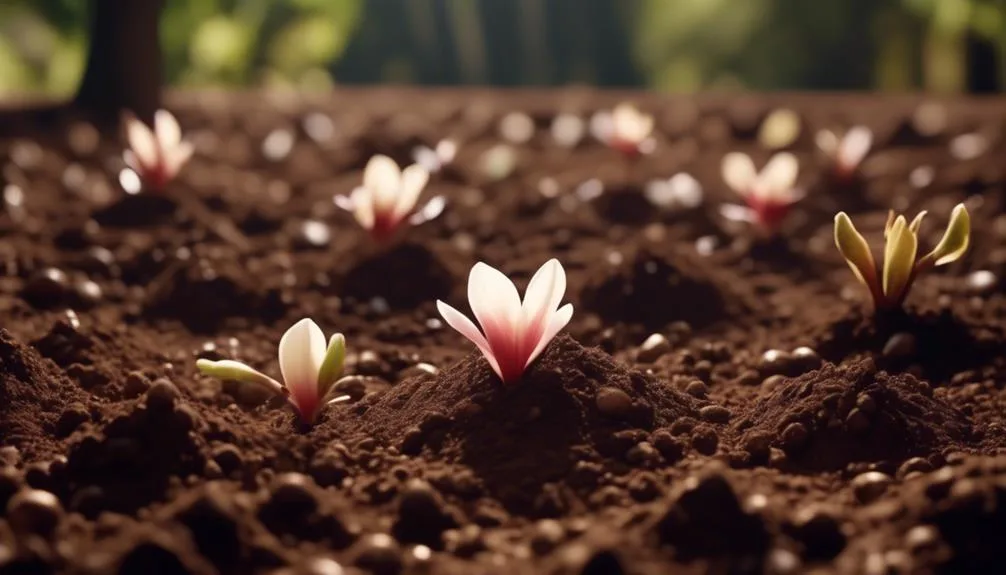Planting magnolia trees is more than just knowing that they thrive in acidic soil. The right soil is key to their success and considering factors like pH, texture, and fertility is important. Understanding these requirements ensures the tree's well-being and enhances its beauty as a stunning addition to your landscape.
Acidic Soil Requirements for Magnolia Trees
To ensure the healthy growth of your magnolia trees, it's essential to consistently provide them with acidic soil. The ideal soil composition for magnolia trees is acidic, with a pH level between 5.0 and 6.5. This acidic environment enhances nutrient availability, particularly for essential elements like iron and magnesium. These elements are vital for the overall health and development of the trees.
Magnolia trees are sensitive to high levels of alkalinity in the soil. This can lead to nutrient deficiencies and negatively impact their growth. Therefore, maintaining the right soil pH is crucial for ensuring that your magnolia trees receive the necessary nutrients for their optimal growth and beautiful blossoms.
Well-Draining Soil for Healthy Magnolia Growth
For healthy magnolia growth, ensuring well-draining soil is as crucial as maintaining acidic soil to promote vibrant foliage and overall tree health.
Well-draining soil is essential for magnolia trees as it prevents waterlogged conditions that can lead to root rot and other diseases. The ideal soil composition for magnolias is a mix of organic matter such as compost or peat moss, along with sand and loam to improve drainage. This type of soil allows for proper water retention, ensuring that the roots receive adequate moisture without becoming waterlogged.
When planting magnolia trees, it's important to amend the soil with organic matter to improve its drainage capabilities. By ensuring well-draining soil, you create the optimal growing conditions for healthy and thriving magnolia trees.
Soil Texture Preferences for Magnolia Trees
When selecting soil for planting magnolia trees, consider the texture that will best promote healthy root development and overall tree vigor. The soil texture preferences for magnolia trees are crucial for their growth and sustainability.
Here are some key points to consider:
- Soil Composition: Magnolia trees thrive in well-draining soil with a balanced composition of sand, silt, and clay. This composition provides the necessary structure for root penetration and aeration.
- Moisture Retention: The ideal soil texture for magnolia trees should have the ability to retain moisture while also allowing excess water to drain away. This balance is essential for preventing waterlogged conditions that can harm the tree's roots.
- Loose and Porous: A loose and porous texture promotes good drainage and aeration, which are vital for the health and growth of magnolia trees.
Carefully selecting the right soil texture will ensure that magnolia trees have the best environment for thriving.
Best Soil Ph Levels for Planting Magnolia Trees
Considering the crucial role of soil texture in promoting healthy root development for magnolia trees, it's essential to understand the best soil pH levels for their successful planting.
Magnolia trees thrive in slightly acidic to neutral soil, with an ideal pH range between 5.5 and 7.0. This pH range facilitates the availability of essential nutrients to the magnolia tree roots.
Soil moisture also plays a significant role in maintaining the appropriate pH levels. Adequate soil moisture helps to regulate pH levels, preventing extreme acidity or alkalinity. Additionally, proper soil moisture supports the uptake of nutrients, contributing to the overall health and growth of magnolia trees.
Ensuring balanced nutrient levels in the soil is crucial for maintaining the optimal pH levels for magnolia tree planting, as it directly influences their ability to thrive and flourish.
Soil Fertility Considerations for Magnolia Tree Planting
To ensure optimal growth and health of your magnolia trees, it's essential to carefully consider the soil's fertility when planning for their planting. When considering soil fertility for planting magnolia trees, it's important to take into account the following factors:
- Nutrient Retention: Choose soil that can hold essential nutrients like nitrogen, phosphorus, and potassium, which are crucial for the healthy growth of magnolia trees. Opt for soils with good organic matter content to enhance nutrient retention. Consider soil types with a balanced pH level to ensure proper nutrient availability for the trees.
- Soil Composition: Select loamy soil with good drainage and aeration properties to provide a suitable environment for the development of magnolia tree roots. Avoid heavy clay soils that may impede proper root growth and hinder nutrient uptake.
Conclusion
In selecting the right soil for magnolia trees, prioritize acidic, well-draining soil with a slightly sandy texture and a pH level between 5.0 and 6.5.
Evaluate soil fertility and make necessary adjustments before planting.
This proactive approach lays the foundation for the thriving growth of your magnolia trees, ensuring a healthy and flourishing environment for years to come.
Happy planting!
Mark Hoffman is a dedicated arborist and tree care specialist with over a decade of experience. His love for trees began when he visited Yosemite National Park as a teenager and was awestruck by the giant sequoias. Mark pursued his passion by studying forestry at Michigan Technological University, where he earned a Bachelor of Science degree.
Since then, he has worked tirelessly in the field of arboriculture, helping to preserve and protect trees in his community. His expertise and dedication have made him a respected leader in the industry and a valuable resource for anyone seeking advice on tree care.
